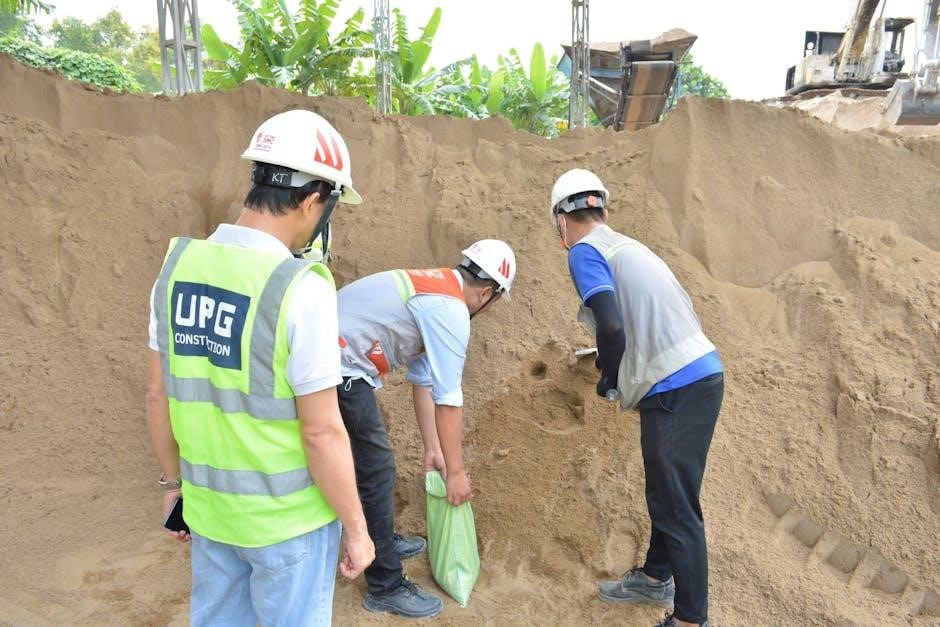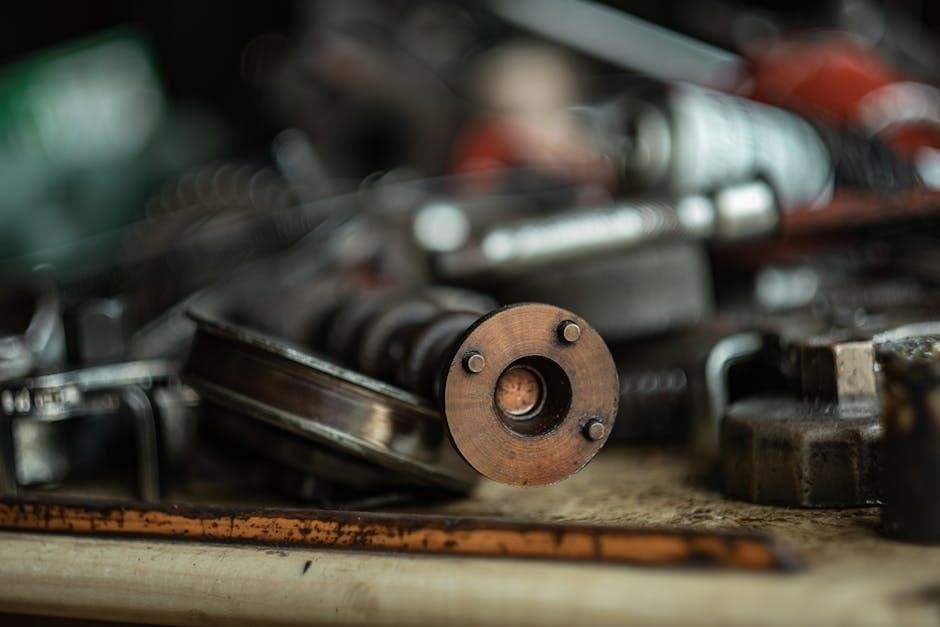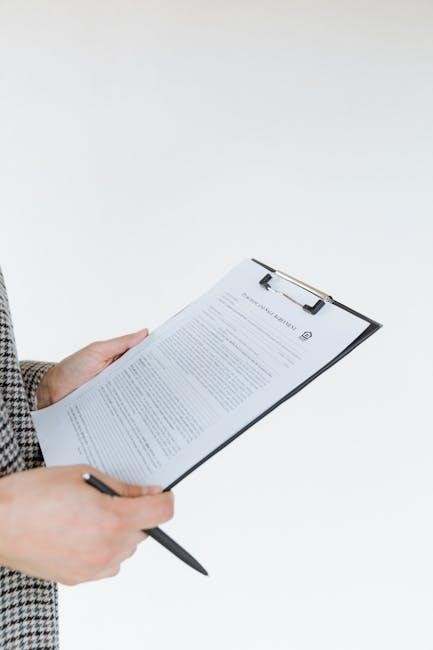A used RV inspection checklist PDF is a comprehensive tool designed to guide buyers through a detailed evaluation of a recreational vehicle’s condition, ensuring a thorough pre-purchase assessment.
1.1 Importance of a Comprehensive Inspection
A thorough inspection is crucial for identifying potential issues like water damage, mechanical faults, or electrical problems. It ensures safety, prevents costly surprises, and provides peace of mind, making it an essential step in the RV buying process.
1;2 Purpose of a Used RV Inspection Checklist PDF
The purpose of a used RV inspection checklist PDF is to provide a structured guide for evaluating the condition of a pre-owned recreational vehicle. It helps buyers identify potential issues, prioritize repairs, and make informed decisions, ensuring a smooth and confident purchase process.
Exterior Inspection
The exterior inspection involves evaluating the RV’s outer condition, checking for damage, leaks, tire wear, and towing component functionality to ensure structural integrity and safety.
2.1 Visual Assessment of the RV’s Exterior
Begin by walking around the RV to identify any obvious defects, scratches, or signs of wear. Inspect the condition of walls, doors, and windows for damage or leaks. Check the integrity of seals and caulking to ensure they are intact and functional, preventing water intrusion or air leaks.
2.2 Checking for Signs of Damage or Leaks
Examine the RV for water damage, stains, or discoloration on walls and ceilings. Check for soft spots on the roof and inspect seals around windows and doors for cracks or gaps. Look for signs of leaks in plumbing lines and around appliances, ensuring no moisture or mineral buildup is present.
2.3 Evaluating Tires, Wheels, and Towing Components
Inspect tires for tread depth, uneven wear, and signs of damage. Check wheels for rust or dents and ensure rims are in good condition. Examine towing components, including the hitch, for proper attachment and function. Verify all bolts and connections are secure and free from rust or damage.

Interior Inspection
Examine walls, floors, and ceilings for damage or water stains. Inspect doors, windows, and screens for proper function. Evaluate the condition of interior appliances and fixtures for operational efficiency.
3.1 Assessing the Condition of Walls, Floors, and Ceilings
Check for water stains, mold, or structural damage on walls, floors, and ceilings. Ensure surfaces are secure and free from cracks or delamination. Look for signs of wear, such as faded paint or warped panels, and verify all surfaces are clean and well-maintained for a safe and comfortable living space.
3.2 Inspecting Doors, Windows, and Screens
Inspect doors, windows, and screens for proper function and damage. Ensure doors open and close smoothly, windows seal tightly, and screens are free of tears. Check for alignment issues, worn-out hinges, or broken latches. Verify all components are secure and functional to maintain the RV’s structural integrity and comfort.
3.3 Evaluating Interior Appliances and Fixtures
Evaluate interior appliances and fixtures for functionality and condition. Check the refrigerator, stove, and HVAC system for proper operation. Inspect cabinetry, countertops, and plumbing fixtures for damage or wear. Ensure all lighting, vents, and safety devices, such as smoke detectors and propane alarms, are in working order to guarantee comfort and safety inside the RV.

Mechanical Systems
Inspecting the mechanical systems of a used RV ensures the engine, transmission, brakes, and suspension are in good working condition. Look for signs of wear or damage to components like belts, hoses, and hydraulic systems, and consider having a qualified mechanic evaluate the chassis and drivetrain for any potential issues.
4.1 Engine and Transmission Condition
Inspect the engine for signs of wear, leaks, or damage. Check the transmission for smooth operation and proper fluid levels. Review maintenance records to ensure regular servicing. Look for any signs of overheating or excessive mileage that could indicate potential issues. Verify that all belts and hoses are in good condition.
4.2 Checking Brakes and Suspension
Inspect brake pads, rotors, and lines for wear or damage. Check suspension components, including shocks, springs, and bushings, for signs of deterioration. Test brakes during a test drive to ensure proper function. Look for any rust, leaks, or alignment issues that could compromise safety or performance. A qualified mechanic can help identify hidden problems early.
4.3 Evaluating Hydraulic and Chassis Components
Inspect hydraulic lines, slide-outs, and leveling jacks for proper function and leaks. Check chassis components, including frame rails and crossmembers, for signs of rust or damage. Ensure all hydraulic systems operate smoothly and test jacks for stability. A qualified RV inspector can help identify hidden issues affecting safety and performance.

Electrical Systems
Inspecting electrical systems ensures safety and functionality. Check wiring, circuits, and electrical panels for damage or wear. Test all lights, outlets, and electronics to confirm proper operation. Verify battery condition and charging systems for reliability. A thorough evaluation helps identify potential issues before they cause problems.
5.1 Testing Lights, Outlets, and Electrical Panels
Test all interior and exterior lights to ensure they function properly. Check outlets for power using a multimeter or by plugging in devices. Verify circuit breakers are operational and no tripped switches remain. Inspect electrical panels for signs of wear, damage, or overheating, ensuring all components are secure and functioning as intended.
5.2 Inspecting Batteries and Charging Systems
Inspect the condition and age of the RV’s batteries, ensuring terminals are clean and connections are secure. Check the charge level and test the charging system’s functionality. Look for signs of wear, corrosion, or damage to cables and connections, ensuring all components are in proper working order.
5.3 Checking for Proper Function of Electronics
Test all electronic components to ensure they are functioning correctly. Check lights, appliances, and entertainment systems. Verify that remotes and controls operate smoothly. Look for consistent performance across all systems and note any malfunctions or needed repairs to ensure reliability and safety.
Plumbing Systems
The plumbing system is crucial for water supply and waste management. Inspect fresh water tanks, pumps, hoses, and waste lines for leaks or damage. Ensure all components function properly to maintain hygiene and prevent costly repairs.
6.1 Inspecting Fresh Water Tanks and Pumps
Inspect fresh water tanks for cracks, rust, or corrosion. Check the water pump for proper function, ensuring it delivers water without leaks. Test the water flow and pressure to confirm the system operates efficiently. Verify all connections are secure and free from damage or wear.
6.2 Checking for Leaks in Water and Sewer Lines
Inspect all water and sewer lines for visible leaks, corrosion, or damage. Pressurize the system to identify hidden leaks. Check connections, hoses, and valves for tightness. Ensure the sewer hose and fittings are in good condition to prevent any issues during use.
6;3 Evaluating the Condition of Holding Tanks
Evaluate the condition of holding tanks by inspecting for cracks, corrosion, or signs of wear. Ensure proper venting and functional sensors. Check for any blockages or damage to valves and connections. Test for leaks under pressure to confirm the tanks are secure and functioning correctly, preventing potential issues during use.

Propane and Gas Systems
Inspect propane tanks, hoses, and connections for damage or leaks. Test propane appliances for proper function and ensure the system is safe and operational before use.
7.1 Inspecting Propane Tanks and Hoses
Examine propane tanks for rust, dents, or corrosion. Check hoses for cracks, abrasions, or signs of wear. Ensure all connections are tight and free from leaks. Verify the condition and security of propane components to guarantee safe and reliable operation during travel.
7.2 Checking for Leaks in the Propane System
Inspect the propane system for leaks by applying a soapy water solution to hoses and connections. Turn on the propane and look for bubbles, which indicate leaks. Ensure all fittings and valves are secure. Use a gas leak detector for added safety. This step is crucial for ensuring safe and functional propane operation.
7.3 Testing Propane Appliances
Test all propane-powered appliances, including the stove, furnace, and water heater. Turn each appliance on to ensure proper function and safe operation. Check for consistent flames, correct burner performance, and verify that all appliances cycle on and off smoothly. This ensures the propane system is operational and safe for use.

Appliances and Features
This section evaluates key RV appliances and features, ensuring they operate effectively and are in good condition, crucial for a comfortable and safe RV experience.
8.1 Evaluating the Condition of the Refrigerator and Stove
Inspect the refrigerator and stove for damage, wear, and proper functionality. Check for rust, dents, or signs of leaks. Ensure all burners and cooling systems operate correctly. Verify secure installation and test functionality with a propane connection. Look for any blockages or worn-out seals that could affect performance.
8.2 Inspecting the HVAC System
Inspect the HVAC system for proper heating, cooling, and ventilation. Check for leaks in ducts and vents. Test functionality by running the system with propane. Ensure secure installation and look for blockages or worn components that could reduce efficiency. Verify thermostat operation and overall system performance.
8.3 Checking for Proper Function of Safety Devices
Inspect smoke detectors, carbon monoxide detectors, and fire extinguishers to ensure they are functional and properly installed. Test emergency exits and propane detectors for quick response. Verify all safety devices meet current standards and are free from tampering or damage, ensuring occupant safety and compliance with regulations.

Roof and Walls
Inspect the roof and walls for signs of leaks, water damage, or structural weaknesses. Check seals and caulking for integrity, ensuring no gaps or deterioration compromise the RV’s stability.
9.1 Inspecting for Signs of Leaks or Water Damage
Check the roof and walls for water stains, discoloration, or soft spots indicating leaks. Look for mold or mildew, which signal prolonged moisture exposure. Ensure all seams and joints are sealed properly to prevent future water infiltration. Use a flashlight to inspect dark or hard-to-reach areas thoroughly for any hidden damage.
9.2 Checking the Condition of Seals and Caulking
Examine all seals and caulking around windows, doors, and joints for cracks, wear, or gaps. Ensure they are intact to maintain watertightness and prevent water damage. Check for any signs of deterioration or separation, as compromised seals can lead to leaks and structural issues over time. Replace any damaged or aged materials promptly.
9.3 Evaluating the Structural Integrity of the Roof
Inspect the roof for signs of damage, sagging, or water leaks. Check for cracks, delamination, or weak spots in the roofing material. Ensure all vents, skylights, and seams are properly sealed. Verify that roof supports and framing are sturdy and free from rot or corrosion. A compromised roof can lead to significant structural issues.

Documentation and Maintenance History
Reviewing service records and maintenance logs ensures transparency about the RV’s upkeep. Verify the accuracy of mileage and check for any unresolved recalls or pending issues.
10.1 Reviewing Service Records and Maintenance Logs
Examine the RV’s service history to ensure all maintenance tasks were performed as recommended. Check for consistency in documentation and verify that major systems, like brakes and engines, have been serviced. Look for records of repairs or replacements to assess the vehicle’s overall condition and care history.
10.2 Checking for Any Outstanding Recalls or Issues
Verify if the RV has any unresolved recalls or issues by checking its VIN against manufacturer databases. Ensure all safety and performance-related recalls have been addressed. This step is crucial for ensuring the vehicle’s safety, reliability, and compliance with regulations, which can significantly impact the purchase decision.
10.3 Verifying the Accuracy of the RV’s Mileage
Verify the RV’s mileage by cross-referencing the odometer reading with service records and maintenance logs; Ensure the mileage aligns with the vehicle’s history and condition. Discrepancies may indicate potential issues or tampering, which could affect the RV’s value and reliability. Accurate mileage is crucial for making an informed purchase decision.

Tools and Preparation for Inspection
A flashlight, tire pressure gauge, multimeter, gloves, and screwdrivers are essential tools. Prepare by gathering all necessary items and reviewing the checklist to ensure a systematic evaluation.
11.1 Essential Tools for a Thorough Inspection
A flashlight, multimeter, tire pressure gauge, wrench, pliers, screwdrivers, and a ladder are essential. Include a level for assessing alignment and a checklist to track findings, ensuring no critical areas are overlooked during the evaluation process.
11.2 Preparing for the Inspection Process
Begin by gathering all necessary tools and the RV inspection checklist PDF. Familiarize yourself with the RV’s systems and review maintenance records. Plan a systematic approach to evaluate exterior, interior, and mechanical components. Ensure all utilities are functional and accessible for testing to identify potential issues and ensure a smooth process.

11.3 Understanding the Checklist Format and Structure
The RV inspection checklist PDF is organized into clear sections, covering exterior, interior, and mechanical systems. Each category includes specific items to evaluate, with space for notes or photos. Prioritize issues based on severity and use the summary section to review findings, ensuring a structured and efficient inspection process.
A used RV inspection checklist PDF ensures a confident purchase by identifying potential issues and verifying the vehicle’s condition, helping buyers make an informed decision.
12.1 Summarizing Key Findings from the Inspection
Summarizing key findings from the inspection involves compiling and evaluating results from the used RV checklist, noting any issues like water damage, mechanical flaws, or needed repairs. This step ensures clarity on the RV’s condition, helping buyers understand its value and potential risks before finalizing a purchase decision.
12.2 Making an Informed Purchase Decision
Making an informed purchase decision involves evaluating the RV’s condition, weighing identified issues against its value, and considering future maintenance costs. The checklist helps buyers compare options, negotiate prices, and avoid hidden pitfalls, ensuring a confident and well-reasoned decision that aligns with their needs and budget.
12.3 The Importance of a Pre-Purchase Inspection
A pre-purchase inspection is crucial for identifying potential issues, ensuring safety, and avoiding costly surprises. It provides a clear understanding of the RV’s condition, helping buyers make a smart investment and enjoy their purchase with confidence, free from hidden problems.
